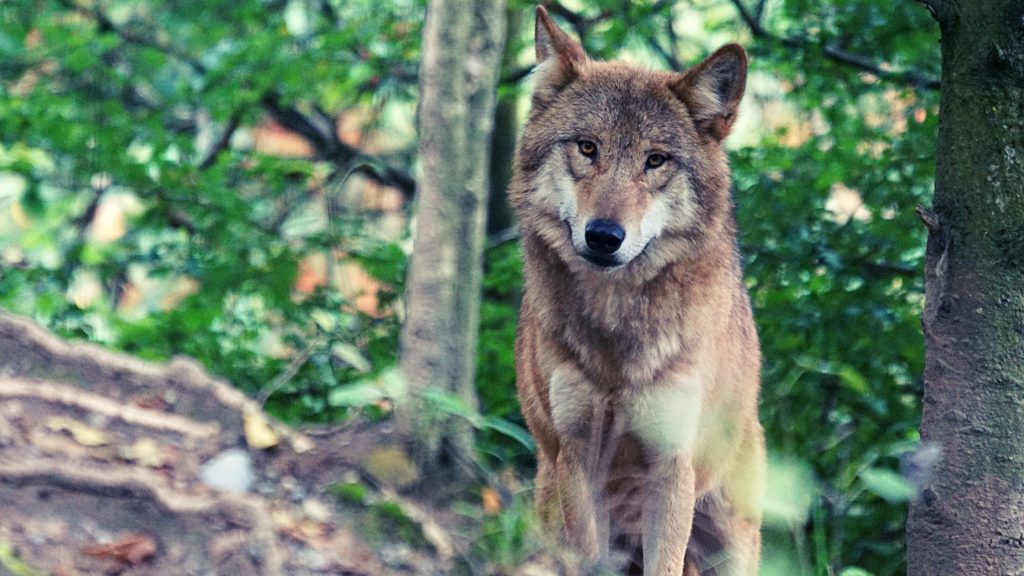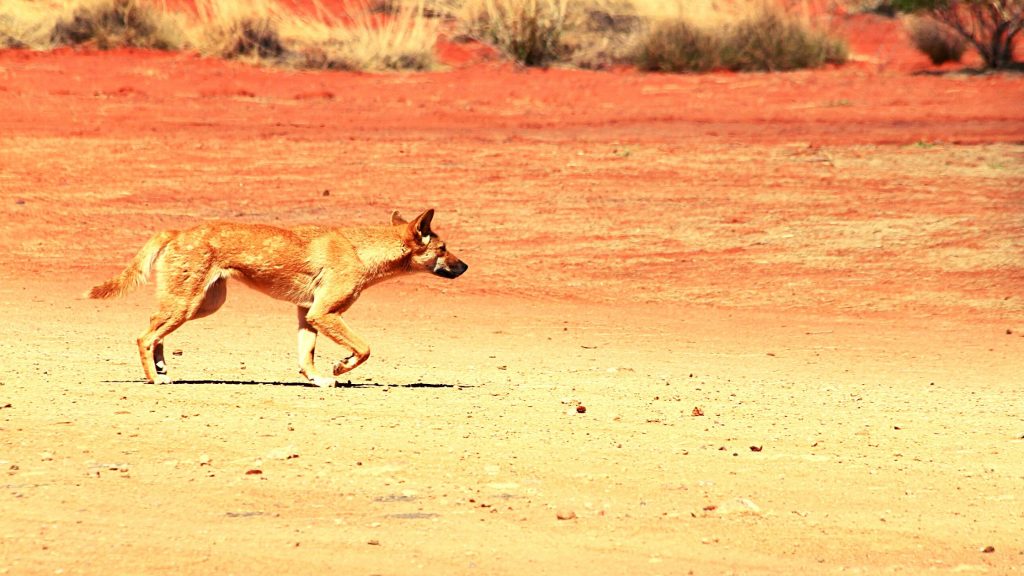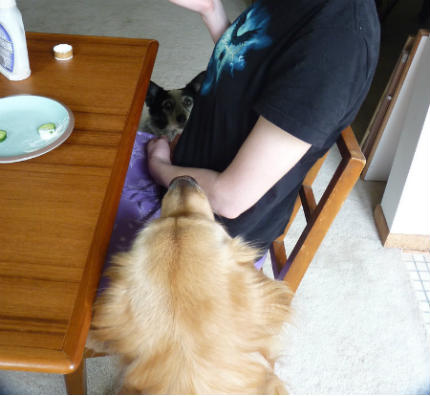In Australia there is a rather unclassifiable canid called the dingo. Zoologists have been arguing for years about whether it is a wolf, a wild dog or a domestic one without reaching an agreement.
Right now it is a vulnerable species , since it is hybridizing with dogs and is even sold as a pet, which will put this animal in danger in the coming years if things do not change.
- Size : up to 59 cm for males.
- Weight : its average weight is up to 32 kilos
- Hair type : It is usually earthy in color, with tones such as yellow, red, and you can see mixtures of both. If the animal is pure, it will have white hair in areas such as the tip of the tail, legs and chest. Its length is medium.
- Character : It is very similar to that of the wolf, and the males can become very aggressive during the mating season.
- Health : good, because in theory it is a wild animal.
- Life expectancy : about 12-15 years.
What is a Dingo or Canis lupus dingo?
To this day it is not well known what a dingo is and there have been eternal discussions between experts for many decades. One of the opinions is that it is a dog, an ancient lineage that arrived in Australia at some point and developed there apart from domestic dogs.
Others say that it is a domestic dog as such, that it is the same as those we have had at home for thousands of years, while there are those who opt because it is a subspecies of dog or wolf that traces its origins to the Asian wolf.
Finally, other specialists say that it is nothing of the above and that it is a separate species, so the confusion continues even though there has been news of it since the 19th century.
Perhaps one of the best definitions that have been given of this animal belongs to the anthropologist Pat Shipman, who tells us that the dingo is a wolf that was going to become a dog, but never completed the process.
It is increasingly difficult to distinguish it from dogs , since it has been hybridizing with them for a long time and that is endangering the survival of this animal, which may disappear in the coming decades.

History of the dingo
It seems that the origin of the dingo may be in New Guinea, since it is very closely related to the New Guinea singing dog or the New Guinea highland wild dog.
Thanks to genetics we know when it first arrived in Australia, something it did around 8,000 years ago, finding fossils dating back to around 3,500.
It is known that it had to be brought by some human population that arrived by sailing to what is now Australia , but it is not known which one and it did not carry out any type of selection, because thanks to the fossils we know that during those more than three millennia The dingo has not changed its appearance.
Around 1788, the first British settlers who arrived in Australia commented that there were some dogs that accompanied the indigenous Australians, so it seems that they had domesticated them and a symbiotic relationship was established between the two.
Coexistence with the settlers was not good, because as they began to take cattle, the dingo saw the cows and sheep as easy prey and did not take long to attack them, so measures were taken in order to control their numbers, which They have never been very efficient.
In fact, dingo populations rose as those of the settlers did, as they introduced new species to Australia such as sheep or rabbits, which served as food for the dingo.
There were more problems with the sheep, but none with the rabbit, because he could hunt them in the field without bothering people, who left him alone if he didn't go near the livestock.
Right now it is recognized as a native animal of Australia , so it enjoys protection in some areas of the country, although it seems that hybridization may put an end to it.
It is not usually represented in cave paintings, which is rare due to its age and it is a very prominent animal in the Dreamtime stories of the Australian Aboriginals.

Dingo Characteristics
At the moment we see them, what happens before our eyes is a dog, which when adult can measure 50 to 59 cm and weigh between 23 and 32 kilos, although some animals have been seen that have exceeded 50, which It is very exceptional.
As in most dog breeds, males are larger than females, and this change in size also occurs within males depending on where they live, since those from South Australia are almost always smaller than those from the north or west.
If we have time to look at them calmly, we can realize that compared to a similar dog, the dingo has a larger snout and longer incisors, although perhaps only specialists can see this.
The skeleton is where it is most distinguished from dogs, since the bones are flatter and the neck area is larger.
Their hair has colors designed not to stand out in the Australian desert environment, so it is possible to see different shades of yellow and red, with albino specimens being exceptionally visible.
The fur may be a different color, which means that this specimen is not a pure dingo, which also has white spots on its legs and chest, as well as on the tip of its tail.
They usually live alone, although they all belong to herds that do not spend 24 hours together , but rather meet once every few days and are made up of up to 12 animals, as long as there is reduced human activity in the area.
Within the packs, they establish different hierarchies for males and females, and only the dominant pair reproduces, something that is simple, since the female remains in heat for two consecutive months a year, always in the same season.
The rest of the members of the herd are dedicated to raising the cubs, so the population of these animals has not grown uncontrollably, especially considering that they have been controlled and killed since the first white man placed a foot in Australia.
It barely barks and does howl like wolves, having three basic howls that serve to attract group members or to warn of the presence of intruders.
A single pack can have a huge territory of more than 200 square km, which depends a lot on how dispersed its prey is, which on a continent of this type can mean a large number of km to cover.
In fact, animals have been studied that have traveled up to 250 km from their place of birth, so they are capable of traveling enormous distances.
Feeding
Dingoes eat everything and are not picky when it comes to choosing their diet, since in Australia it is known that their diet includes more than 170 species , with very diverse sizes ranging from small insects to enormous water buffaloes.
Depending on the region where they live, dingoes are more specialized in one or another animal when hunting, and those who live in the north capture the magpie goose, the dusty rat and even the wallaby, which is like a kangaroo in miniature.
There are also dingoes in Asia and here their diet changes, because due to the overpopulation of the continent they are closer to humans.
In this way, while in Australia they are carnivores, in Asia they are omnivores and do not dislike foods such as rice or fruit that humans give them.
Their way of hunting varies depending on the size of the prey they are going to stalk. Thus, if it is small animals like a rabbit they do it alone, but if they go after kangaroos they create groups just like wolves.
We must not forget that livestock is also a part of their diet, although it is true that only in those times when the species they usually hunt are scarce.

Where they live?
Currently, their main habitat is in Australia, although there are several areas where there is hardly any population of these animals, such as the southeast of Tasmania and a part of the southwest of the island.
In addition, it is present in Southeast Asia , where it seems to originate, in countries such as Indonesia, Thailand or the Philippines, although there are not populations as large as those in Australia, perhaps because human pressure is greater in this area.
The Dingo as a pet
Is it possible to have a dingo as a pet? The answer is yes, but only if we live in Australia, since there it is considered a vulnerable species and cannot be taken out of the country.
It is fashionable to have these animals as if they were dogs , and in fact it seems that there are even kennels specialized in them, although they do not always keep them in the best conditions, and that is why it is recommended to adopt one if possible.
You should never pick up any adults from the street, as they are still wild canids, which can become very aggressive when they are confined in a home or in a garden, at which point they attack.
Among their virtues are that they are very independent, that they do not smell and that they hardly bark, although they do howl.
Being so independent allows you to have a type of dog that is less attached to its owner, which is what some people look for in rural areas where these animals usually live in conditions of semi-freedom.
Of course, we must never forget that they are not actually domesticated, so you always have to be careful with them, especially during the breeding season when the males will try to escape using the means at their disposal.
Educating him is not easy at all, so training him to listen to our commands can be almost impossible, something that we must be willing to accept with these animals.
In fact, it would be advisable to have some type of prior training before he arrives home, because if we are going to have him like any other dog, he must learn some rules that will not be easy to teach him.
Kept as a pet you will hardly need to visit the veterinarian, since having been selected in nature it is very resistant to all diseases.
As for feeding, they don't cause problems, but if we have them as pets, the simplest thing is to give them quality feed, suitable for the size they have, which if taken to that of dogs would be the average, similar to that of a German shepherd.
If you give it premium food, it will live better and have excellent health, although you can also feed it with meat, whatever is on the market at a low price at that time.
It is advisable that the meat be cooked, as this will prevent parasitic diseases that can affect the dingo in the same way as any other dog or wolf.
How much does a Dingo cost?
Within Australian territory you can buy a dingo for a price between $500 and $1,000 , a reasonable amount if we take into account the standard of living in the area, so it can even be said that it is cheap.
There are specialized kennels that are legal there, so living in Australia we can have our own dingo.
Other articles that may interest you:












